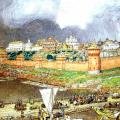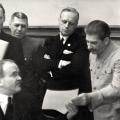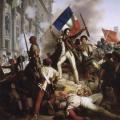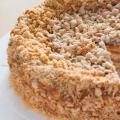Ivan II Ivanovich the Red (baptized John)
Years of life: 03/30/1326 - 11/13/1359
Reign: 1353-1359
From the family of Moscow Grand Dukes.
Son from Princess Elena.
Prince of Zvenigorod until 1354.
Grand Duke of Moscow in 1354 - 1359.
Grand Duke of Vladimir in 1354 - 1359.
Prince of Novgorod in 1355 - 1359.
Born on March 30, 1326 in Moscow. Ivan Ivanovich most likely received his nickname “Red” due to his exceptional appearance (red from the word beautiful). In the chronicles there are other names and nicknames of this prince - “Merciful”, “Meek”.
In 1340, after the death of Ivan Danilovich's father, he took possession of the cities of Zvenigorod and Ruza.
Son of Prince Ivan II the Red - Dmitry
In 1341 Ivan 2 Red married Princess Feodosia of Bryansk, daughter of Prince Dmitry of Bryansk. In connection with her death during the years of the plague, in 1345 he remarried Alexandra Ivanovna (?–1364), who bore him a son, Dmitry (the future), on October 12, 1350, and later another son, Ivan Ivanovich Maly, who lived only 10 years (1354–1364), and also 2 daughters - Lyubov (according to other sources - Anna, who became the wife of the famous commander, Prince D.M. Bobrok of Volyn, a participant in the Battle of Kulikovo, and Maria, who married the prince Dmitry Olgerdovich.
According to his spiritual father, Ivan Ivanovich the Red inherited 23 more cities and villages in addition to Zvenigorod and Ruza. The plague claimed the lives of many of his relatives, including his brother, the ruler of Moscow, and his second elder brother, Andrei Ivanovich. The widow of Semyon the Proud Maria gave Ivan II everything bequeathed by her husband.
Reign of Ivan II the Red
And in 1353 Ivan II the Red received a label for the great reign in the Golden Horde after the death of his elder brother Simeon the Proud, received Moscow rule, but did not reign for long.
During his reign, Ivan Ivanovich continued the policies of his father and older brother - the policy of strengthening the power of the Moscow princes in Rus'.
However, in the struggle for the right to receive a label for the great reign of Vladimir, Ivan Ivanovich the Red quickly emerged as a rival - the Nizhny Novgorod-Suzdal prince Konstantin Vasilyevich, who enjoyed the support of the Novgorodians. Despite all the obstacles, Ivan II managed to win and receive a label from the Horde Khan Janibek.

According to surviving chronicle sources, Ivan Ivanovich the Red was a “quiet, meek, merciful and unambitious” ruler. He lived in complete silence, and therefore had peace everywhere.” But despite all his peace-loving character, Ivan II Ivanovchia had strong support in the person of the Moscow boyars and was ordained in 1354, having previously been the bishop of Vladimir. It was Metropolitan Alexy who often traveled to the Horde, maintained peaceful relations and, according to existing legend, healed the khan’s wife Taidula from blindness. This is what allowed the Metropolitan to dissuade the Khan from another devastating raid on Rus'.
Ivan Krotky
Ivan II Ivanovich the Red at this time - according to the same legend - remained in the Moscow reign and ordered that the Tatar prince Mamat-Khoja not be allowed in. The Tsarevich allegedly obeyed, left, and the Moscow prince Ivan the Red received the nickname “Meek.” As proof of his “meekness,” Ivan II Ivanovich did not offer military resistance to the offensive of the Grand Duke. Lithuanian Olgerd.
When Olgerd captured the city of Bryansk and went to Mozhaisk, Ivan II Ivanovich, according to the chroniclers, did not interfere with him and gave the Mozhaisk people the opportunity to defend themselves.
At the same time, it was under Ivan II that the Kostroma and Dmitrov lands became part of the Moscow principality, and the prince himself, with the help of Metropolitan Alexei, managed to achieve not only a label for the great reign, but also the right of judicial power over other Russian princes.
Ivan II Ivanovich the Red died in Moscow on November 13, 1359, having adopted the schema before his death. He was buried in the Kremlin Archangel Cathedral. After his death, his son, young Dmitry, was left in the care of Metropolitan Alexy, to whom Ivan II Ivanovich entrusted the administration and protection of the principality.
- (Handsome) (30.3.1326 13.11.1359), Russian prince, second son of Ivan I Danilovich Kalita (See Ivan I Danilovich Kalita), father of Dmitry Ivanovich Donskoy, prince of Zvenigorod and Ruz in 1340 53. After the death of his brother, Semyon the Proud , great... ... Great Soviet Encyclopedia
- (Beautiful) (1326 59) rus. Prince, second son of Ivan Kalita, Prince. Zvenigorod and Ruza in 1340 53. After the death of his brother, Semyon the Proud, he led. book Moscow and Vladimir in 1353 59; defended the right to grand dukes. throne in the fight against Suzdal... ... Soviet historical encyclopedia
Ivan II Ivanovich Miniature from the Tsar's titular book 5th Prince of Moscow ... Wikipedia
Wikipedia has articles about other people named Ivan Fedorovich. Ivan Fedorovich 6th Appanage Prince of Starodub ... Wikipedia
Ivan II Ivanovich Miniature from the Tsar's titular book 5th Prince of Moscow ... Wikipedia
Ivan II Ivanovich Miniature from the Tsar's titular book 5th Prince of Moscow ... Wikipedia
- (John Ioannovich) Ivan Ivanovich the Red (1326 1359) Prince of Moscow and Grand Duke of Vladimir. Ivan Ivanovich Korotopol (d. 1343) Grand Duke of Ryazan. Ivan Ivanovich (1496 1533/1534) Grand Duke of Ryazan. Ivan... ... Wikipedia
Ivanovich Miniature from the Tsar's titular book 5th Prince of Moscow ... Wikipedia
IVAN II Ivanovich the Red (March 30, 1326 November 13, 1359), Grand Duke of Vladimir and Moscow (from 1353), second son of Ivan Kalita (see IVAN I Kalita), father of Dmitry Donskoy. In 1340-1353 he was an appanage prince of Zvenigorod and Ruza. After… … encyclopedic Dictionary
Books
- Vintage Russian vaudevilles, Absent. We bring to your attention audio performances of famous vaudevilles of the 19th century, in which famous artists Alexey Gribov, Nikolai Gritsenko, Vasily Merkuryev, Faina Ranevskaya, Ruben take part... audiobook
- Red Laughter (collection), Leonid Andreev. In the prose of Leonid Andreev, reverent emotionality, meticulous interest in the everyday life of Russian life and sometimes irrational fear of the nightmares of the “Iron Age” are intricately intertwined...
Years of life: 03/30/1326 - 11/13/1359
Reign: 1353-1359
Ivan II Ivanovich the Red (baptized John)
From the family of Moscow Grand Dukes.
Son of Ivan I Danilovich Kalita from Princess Elena.
Prince of Zvenigorod until 1354.
Grand Duke of Moscow in 1354 - 1359.
Grand Duke of Vladimir in 1354 - 1359.
Prince of Novgorod in 1355 - 1359.
Born on March 30, 1326 in Moscow. Ivan Ivanovich most likely received his nickname “Red” due to his exceptional appearance (red from the word beautiful). In the chronicles there are other names and nicknames of this prince - “Merciful”, “Meek”.
In 1340, after the death of Ivan Danilovich's father, he took possession of the cities of Zvenigorod and Ruza.
In 1341, Ivan Ivanovich the Red married Princess Feodosia of Bryansk, daughter of Prince Dmitry of Bryansk. In connection with her death during the years of the plague, in 1345 he remarried Alexandra Ivanovna (?–1364), who bore him a son, Dmitry (the future Dmitry Ivanovich Donskoy), on October 12, 1350, and later another son, Ivan Ivanovich Maly, who lived only 10 years (1354–1364), and also 2 daughters - Lyubov (according to other sources - Anna, who became the wife of the famous commander, Prince D.M. Bobrok Volynsky, a participant in the Battle of Kulikovo, and Maria, who married married Prince Dmitry Olgerdovich.
According to his spiritual father, Ivan Ivanovich the Red inherited 23 more cities and villages in addition to Zvenigorod and Ruza. The plague claimed the lives of many of his relatives, including his brother, Semyon the Proud, the ruler of Moscow, and his second elder brother, Andrei Ivanovich. The widow of Semyon the Proud Maria gave Ivan II everything bequeathed by her husband.
And in 1353, Ivan Ivanovich the Red received a label for the great reign in the Golden Horde after the death of his elder brother Simeon the Proud, received Moscow rule, but did not reign for long.
During his reign, Ivan Ivanovich continued the policies of his father and older brother - the policy of strengthening the power of the Moscow princes in Rus'.
However, in the struggle for the right to receive a label for the great reign of Vladimir, Ivan Ivanovich the Red quickly emerged as a rival - the Nizhny Novgorod-Suzdal prince Konstantin Vasilyevich, who enjoyed the support of the Novgorodians. Despite all the obstacles, Ivan II managed to win and receive a label from the Horde Khan Janibek.
According to surviving chronicle sources, Ivan Ivanovich the Red was a “quiet, meek, merciful and unambitious” ruler. He lived in complete silence, and therefore had peace everywhere.” But despite all his peaceful character, Ivan II Ivanovchia had strong support in the person of the Moscow boyars and Metropolitan Alexy, who received the rank in 1354, who had previously been the bishop of Vladimir. It was Metropolitan Alexy who often traveled to the Horde, maintained peaceful relations and, according to existing legend, healed the khan’s wife Taidula from blindness. This is what allowed the Metropolitan to dissuade the Khan from another devastating raid on Rus'.
Ivan II Ivanovich the Red at this time - according to the same legend - remained in the Moscow reign and ordered that the Tatar prince Mamat-Khoja not be allowed in. The Tsarevich allegedly obeyed, left, and the Moscow prince Ivan the Red received the nickname “Meek.” As proof of his “meekness,” Ivan II Ivanovich did not offer military resistance to the offensive of the Grand Duke. Lithuanian Olgerd.
When Olgerd captured the city of Bryansk and went to Mozhaisk, Ivan II Ivanovich, according to the chroniclers, did not interfere with him and gave the Mozhaisk people the opportunity to defend themselves.
At the same time, it was under Ivan II that the Kostroma and Dmitrov lands became part of the Moscow principality, and the prince himself, with the help of Metropolitan Alexei, managed to achieve not only a label for the great reign, but also the right of judicial power over other Russian princes.
Ivan II Ivanovich the Red died in Moscow on November 13, 1359, having adopted the schema before his death. He was buried in the Kremlin Archangel Cathedral. After his death, his son, young Dmitry, was left in the care of Metropolitan Alexy, to whom Ivan II Ivanovich entrusted the administration and protection of the principality.
Prince Ivan II Ivanovich the RedIvan Ivanovich - Prince of Moscow, Prince of Novgorod, Grand Duke of Vladimir.
Ivan II Ivanovich (baptized Ioann Ioannovich) the Red, from the family of Moscow Grand Dukes, was born on March 30, 1326 in Moscow. He is one of the sons of Ivan I Kalita and his first wife Princess Elena. According to the chronicles, Ivan received his nickname “Red” because of his exceptional appearance (i.e. from the word “beautiful”). But there are also his other nicknames - “Merciful” and “Meek”. However, according to the prominent historian N.S. Borisov, the nickname indicated the time of birth of the prince - “Red Hill” (Next Sunday, week after Easter)

Ivan II Ivanovich the Red, Prince of Moscow
After the death of his father in 1341, according to his spiritual will, Ivan received 23 cities and villages, the main ones being Zvenigorod and Ruza. And until 1353 he reigned in Zvenigorod, before the beginning of the pestilence - the plague that claimed the lives of his first wife, many relatives, including two older brothers - Semyon the Proud (ruler of Moscow, Grand Duke) and Andrei.
The thirty-three-year life of Ivan Ivanovich is relatively uneventful. Apparently, thanks to his character, quiet and peaceful. Before he became the Prince of Moscow, chronicles record only a few trips to the Horde and an unsuccessful campaign against the Swedes. In 1339, when he was 13 years old, together with his brothers Semyon and Andrey, he accompanied his father to the Horde. In the autumn of the same year, Ivan visited the Horde once again and left the Horde kingdom in the winter, with a grant and, as the chronicles write, with love. Then, with his brother Semyon, after the death of his father, he visited the Horde: in 1341, 1344 and 1351. In 1347 he went on a campaign against the Swedes. Arriving in Novgorod, Ivan learned that the Swedes had taken the Orekhov fortress, but for an unknown reason he returned back.
In 1353, Semyon the Proud passed away. The Grand Duke died of a “pestilence” (great plague epidemic). According to his father’s will, Ivan Ivanovich inherited the villages of Zvenigorod, Ruza and 21 other villages. Another third of the lands of the Moscow principality from the will of Ivan Kalita (the main cities of Mozhaisk and Kolomna) later also passed to Ivan Ivanovich, since both of his sons died in the plague along with Semyon Ivanovich. A third of the younger Ivanovich Andrei (primarily Serpukhov and Lopasnya), who also died during the plague, passed to his son Vladimir (the future Brave).
The widow of Semyon the Proud Maria gave Ivan the Red everything bequeathed by her husband, and in 1353 he became the ruler of the Moscow principality. In the same year, despite the resistance of the appanage princes, he received a label for the great reign in the Golden Horde. However, in the struggle for the right to receive the label, Ivan had a rival - the Suzdal-Nizhny Novgorod prince Konstantin Vasilyevich, who enjoyed the support of the Novgorodians. As a result of the struggle, Ivan the Red nevertheless became the Grand Duke of Moscow and Vladimir.

Prince Ivan II Ivanovich the Red
During his reign, he continued the policies of his father and older brother - the policy of strengthening the power of the Moscow princes in Rus' and unifying the Russian lands. Also, according to the chronicles, Ivan the Red was a “quiet, meek, merciful and unambitious” ruler. He lived in complete silence, and therefore had peace everywhere.” But, despite his gentle and calm character, Ivan had strong support from the boyars of Moscow and Metropolitan Alexy, whom he left to deal with state affairs. It was Metropolitan Alexy who traveled to the Horde several times during the reign of Krasny and maintained peaceful relations with it.
The period of Ivan the Red's reign was a period of relative weakening of Moscow and strengthening of its neighbors and opponents. The Grand Duchy of Lithuania achieved the approval of a separate metropolitan in Kyiv. Theognost's successor Alexy was arrested in 1358 by order of the Lithuanian prince Olgerd in Kyiv, where he stayed until 1360, and then escaped from custody. Olgerd captured the Bryansk principality and marched on Mozhaisk.

In Tver affairs, Ivan Ivanovich supported Prince Vasily Mikhailovich of Kashin, who occupied the Tver grand-ducal table. When in 1357 the Tver princes, uncle and nephew, Vasily Kashinsky and Vsevolod Alexandrovich Kholmsky, who was laying claim to the grand-ducal table, quarreled, the Grand Duke of Moscow and Vladimir supported Vasily. In 1358, the Moscow and Tver armies together went to take Rzhev from the Lithuanians, which they did. True, Lithuanian troops soon recaptured the city.
The Ryazan principality strengthened. Soon after Ivan Ivanovich left for the Horde, the Ryazan people with their young prince Oleg Ivanovich (the future famous commander) captured Lopasnya (Lopastna) with a sudden blow. The fortress was located on the right bank of the Oka at the confluence of Lopasnya, opposite the mouth of the latter, and was of strategic importance for the Moscow principality. Previously, Lopasnya was part of the Ryazan principality, like Kolomna. The Moscow governor, Prince Mikhail Alexandrovich, was captured and held until a ransom was received. Returning from the Horde, Ivan the Red did not start a war with Ryazan over the city, which belonged to the inheritance of his young nephew, Prince Vladimir Andreevich of Serpukhov, and transferred other lands to him.

Ivan Ivanovich Krasny.
Ivan Ivanovich reconciled with the Nizhny Novgorod-Suzdal Grand Duke Konstantin Vasilyevich only a year before his death. Khan retained the label for Ivan the Red. But after Ivan’s death, the label ended up in the hands of Dmitry Konstantinovich, and Ivan’s heir Dmitry had to return the great reign by force, also taking advantage of the unrest in the Horde.
The reign of Ivan the Red was weak, so Moscow was not able to take advantage of the beginning of the turmoil (“zamyatnya”) in the Horde at that time. Khan Chanibek, whom Russian chronicles called the Good, was killed in 1357 by supporters of his son Berdibek. Supporters of Khan Berdibek also killed 12 of his brothers, thus making Berdibek the only legitimate heir to the Golden Horde throne. Berdibek himself was killed already in 1359. As a result, from 1359 to 1380, more than 25 khans changed on the Golden Horde throne, and many uluses (regions) tried to become independent. A year before the death of Ivan the Red, the Horde prince Mamat-Khozha came to Ryazan and sent to Moscow to announce to the Grand Duke of Moscow and Vladimir that it was necessary to draw precise and inviolable borders between the Ryazan and Moscow lands. However, Ivan Ivanovich did not allow the prince into his land.
At the same time, it was under Ivan II that the Kostroma and Dmitrov lands became part of the Moscow principality, and the prince himself, with the help of Metropolitan Alexei, managed to achieve not only a label for the great reign, but also the right of judicial power over other Russian princes.

Grand Duke Ioan II Ioannovich the Red,
Ivan Krasny was married twice. In 1341, he married the Bryansk princess Feodosia, and after her death during the years of the plague in 1345, he remarried Alexandra Ivanovna, who bore him sons Dmitry (the future Dmitry Donskoy) and Ivan Maly (who lived only 10 years) and daughters - Love (according to other sources - Anna) and Mary.
Ivan II Ivanovich the Red died in Moscow on November 13, 1359, having adopted the schema before his death. He was buried in the Archangel Cathedral of the Kremlin. After his death, his sons, young Dmitry and Ivan, were left in the care of Metropolitan Alexy, to whom Ivan II entrusted the management and protection of the principality.
Ivan Krasny (Ivan II Ivanovich Krasny), whose nickname is the more commonly found Red, analytically implies that the man was very handsome. The Moscow prince was also called the Gracious.
Ivan the Red was the first son of Ivan Kalita, born in March 1326. For the last six years of his life he was the Prince of Moscow. Biography. As an inheritance from his father Ivan Kalita, Krasny inherited the lands of Zvenigorod and settlements in Ruza. Kalita ruled the cities of Kolomna and Mozhaisk, which were inherited by his son Semyon, but Semyon died of the plague and his lands went to Ivan Ivanovich.
During the reign of Prince Krasny, the importance of Moscow weakened in comparison with strong enemy states. Konstantin Vasilyevich, Prince of Nizhny Novgorod and Suzdal, wanted to seize the principality of Vladimir from Krasny. The power of Red was disapproved of by the boyars, who staged coups and left Moscow en masse. Although in 1358 the prince finally reached an agreement.
The date of Krasny's death is subsidized as November 13, 1359. During his life, he ruled for only six years in the Moscow principality. The prince was buried in the lands of the Archangel Cathedral. After his death, he bequeathed the lands belonging to him to his sons.
Family matters
The prince was married twice, first to the boyar daughter of Princess Feodosia Dmitrievna, who died in 1342 after a year of marriage. The second marriage was registered in 1345 with Princess Alexandra Ivanovna. Ivan the Red had four children, two daughters Anna and Olga and two sons Ivan Maly and Dmitry Donskoy.
Cognitive fact
- The historian Borisov believes that the Red Prince received the nickname in honor of his birthday, which according to chronology dates back to the Red Hill holiday, the holiday falls on the first Sunday after the celebration of Great Easter.




